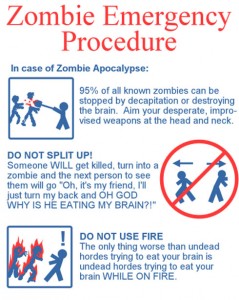 Today we're going to learn a little about zombie stakeholders.
Now, I know you're a little apprehensive. You don't believe in zombies. You believe your stakeholders are just a little bit different. Well, I'm sorry to break it to you but that's not a stubborn human wanting to arm-wrestle you for that last danish. That there's a zombie! How else do you explain that persistent stubbornness? Now, stakeholder zombies are a little different from regular zombies. Rather than brains, these zombies are highly unique and you much adapt to each one independently.
Today we're going to learn a little about zombie stakeholders.
Now, I know you're a little apprehensive. You don't believe in zombies. You believe your stakeholders are just a little bit different. Well, I'm sorry to break it to you but that's not a stubborn human wanting to arm-wrestle you for that last danish. That there's a zombie! How else do you explain that persistent stubbornness? Now, stakeholder zombies are a little different from regular zombies. Rather than brains, these zombies are highly unique and you much adapt to each one independently.
The Undead Stakeholder
Myths and Realities
Here are some specific background data. The first is a fictitious virus called "Solanum" that creates a zombie. The virus is spread (such as through an open wound, when coming in contact with infected blood or saliva), and treatment is limited (usually amputation). Now, there was a mutation of the Solanum virus around the time PMI was created. This mutant virus was known as Solanum-3c (Solanum-3-constraints). Chances are it will only infect your stakeholders but you, as a project manager, may still be a carrier. In reality, stakeholder zombies walk among us. You just have to be on your toes when you're around them. They will try to infect you. Don't let it happen.
Weapons and Combat Techniques
The weapons at the average project manager's disposal aren't quite a dramatic as those used on regular undead. For regular zombies, a common M1 carbine and the machete are highly effective. For stakeholder zombies, finding out what's important to them will stop them dead in their tracks. Different stakeholders have different needs. Zombie stakeholders are no different...with the exception of tattered clothing and a greenish skin tone. If they say Brai...cooooooost, focus on cost. If they say Brai...delivery date, focus on the delivery date. All zombies want brains first. They can't help it. But, after that, find out what is important to your zombie stakeholder and make a note of it.
On the Run
If you're dealing with regular zombies, you need to know rules and necessities of traveling through zombie-infested territory. If you're going to drive a car, make sure you have keyless entry and the windows are rolled up. Do NOT touch the zombies! If you're dealing with zombie stakeholders, don't run. If anything, get as close to them as possible. If given the choice of interacting with them over the phone, through email, or in zombie (in person), choose to interact with them directly. The more attention you give them, the quicker you can react to them and their needs.
On the Attack
Though some believe in avoiding zombies at all costs, which you should, there are strategies and tools to eradicate zombies from an area. For zombie stakeholders, we don't want to eradicate them. Rather, we just want to make them happy. Find out what makes them happy! Now attack.
Conclusion
Though you don't want to get close to regular zombies, you should try to engage the zombie stakeholder. Know what's important to them. Understand their needs. I've made the mistake of sitting in a status meeting with regular zombies. I asked what they wanted to see in the next release. The answer? Brains. I asked how could I streamline communications? The answer? Brains. I drank my coffee and ran.
Don't think the Solanum-3c virus is limited to stakeholders. Elizabeth Harrin over at A Girl's Guide to Project Management wrote an excellent post on zombie project managers. Be afraid. Be very afraid.
Graphic: The Daily Pennsylvanian







